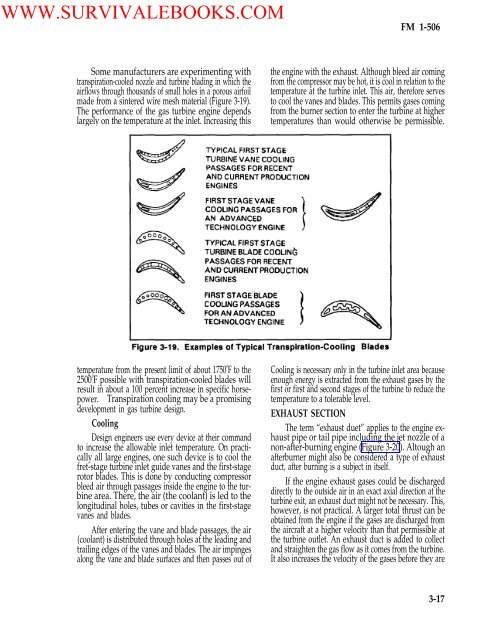FM 1-506 Fundamentals of Aircraft Power Plants ... - Survival Books
FM 1-506 Fundamentals of Aircraft Power Plants ... - Survival Books
FM 1-506 Fundamentals of Aircraft Power Plants ... - Survival Books
You also want an ePaper? Increase the reach of your titles
YUMPU automatically turns print PDFs into web optimized ePapers that Google loves.
WWW.SURVIVALEBOOKS.COM<strong>FM</strong> 1-<strong>506</strong>Some manufacturers are experimenting withtranspiration-cooled nozzle and turbine blading in which theairflows through thousands <strong>of</strong> small holes in a porous airfoilmade from a sintered wire mesh material (Figure 3-19).The performance <strong>of</strong> the gas turbine engine dependslargely on the temperature at the inlet. Increasing thisthe engine with the exhaust. Although bleed air comingfrom the compressor may be hot, it is cool in relation to thetemperature at the turbine inlet. This air, therefore servesto cool the vanes and blades. This permits gases comingfrom the burner section to enter the turbine at highertemperatures than would otherwise be permissible.temperature from the present limit <strong>of</strong> about 1750 0 F to the2500 0 F possible with transpiration-cooled blades willresult in about a 100 percent increase in specific horsepower.Transpiration cooling may be a promisingdevelopment in gas turbine design.CoolingDesign engineers use every device at their commandto increase the allowable inlet temperature. On practicallyall large engines, one such device is to cool thefret-stage turbine inlet guide vanes and the first-stagerotor blades. This is done by conducting compressorbleed air through passages inside the engine to the turbinearea. There, the air (the coolant) is led to thelongitudinal holes, tubes or cavities in the first-stagevanes and blades.After entering the vane and blade passages, the air(coolant) is distributed through holes at the leading andtrailing edges <strong>of</strong> the vanes and blades. The air impingesalong the vane and blade surfaces and then passes out <strong>of</strong>Cooling is necessary only in the turbine inlet area becauseenough energy is extracted from the exhaust gases by thefirst or first and second stages <strong>of</strong> the turbine to reduce thetemperature to a tolerable level.EXHAUST SECTIONThe term “exhaust duet” applies to the engine exhaustpipe or tail pipe including the jet nozzle <strong>of</strong> anon-after-burning engine (Figure 3-20). Altough anafterburner might also be considered a type <strong>of</strong> exhaustduct, after burning is a subject in itself.If the engine exhaust gases could be dischargeddirectly to the outside air in an exact axial direction at theturbine exit, an exhaust duct might not be necessary. This,however, is not practical. A larger total thrust can beobtained from the engine if the gases are discharged fromthe aircraft at a higher velocity than that permissible atthe turbine outlet. An exhaust duct is added to collectand straighten the gas flow as it comes from the turbine.It also increases the velocity <strong>of</strong> the gases before they are3-17
















